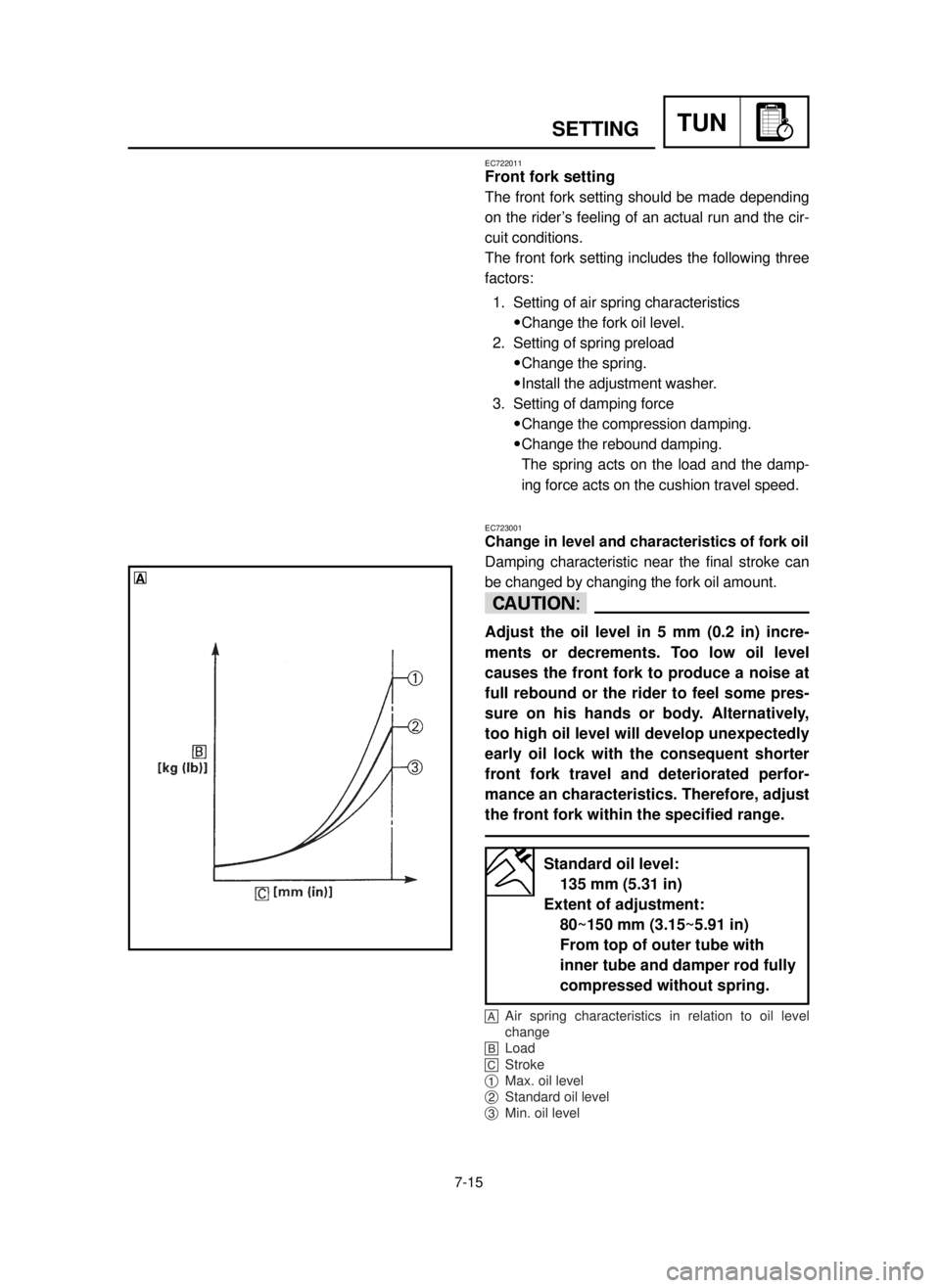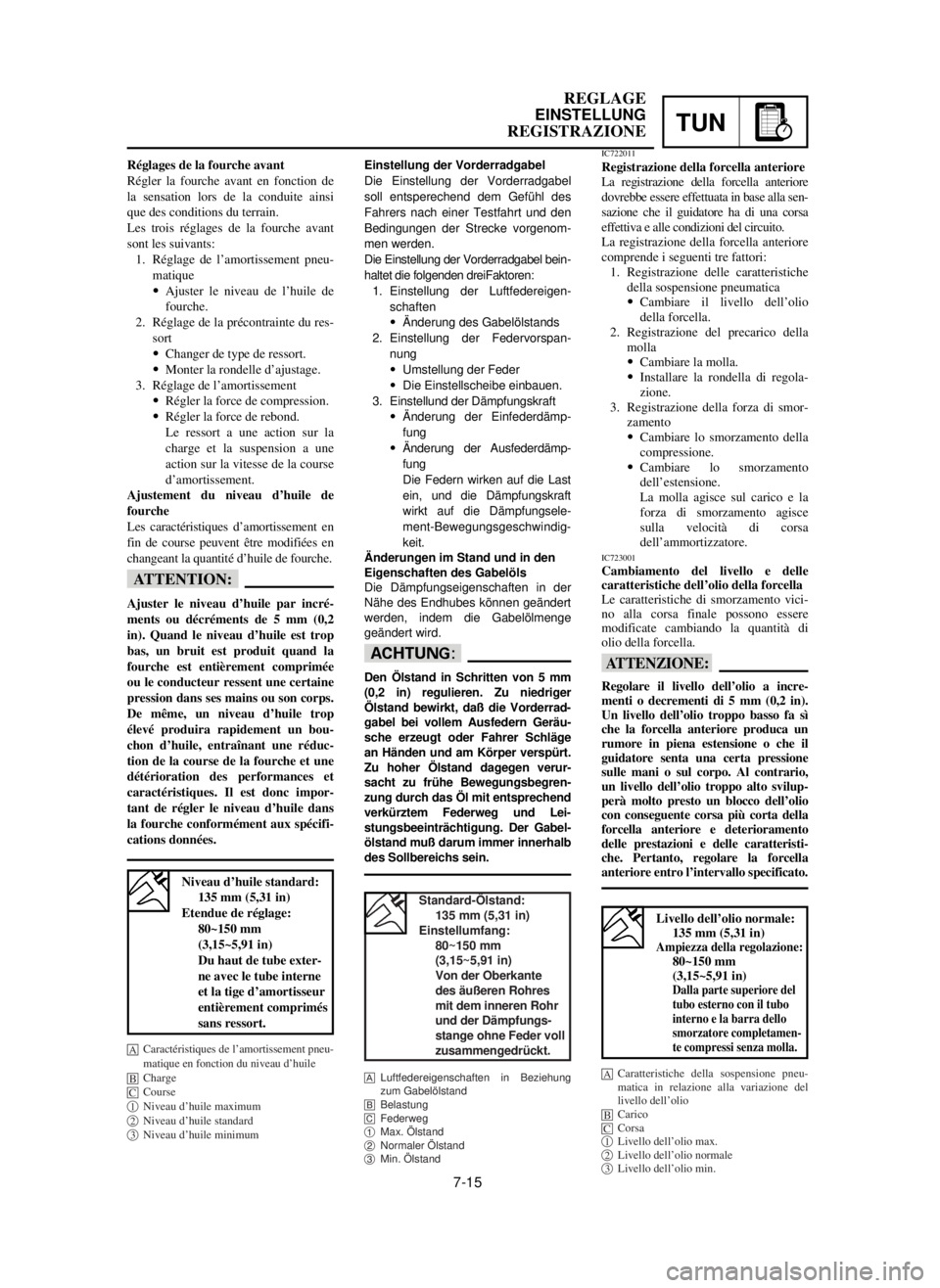YAMAHA YZ125LC 2001 Betriebsanleitungen (in German)
Manufacturer: YAMAHA, Model Year: 2001, Model line: YZ125LC, Model: YAMAHA YZ125LC 2001Pages: 558, PDF-Größe: 13.11 MB
Page 531 of 558

7-14
TUN
REGLAGE
EINSTELLUNG
REGISTRAZIONE
Antriebs- und Abtriebskettenrad-
EinstellteilePièces de réglage des pignons méné et
menant
Pression des pneus
Régler la pression des pneus en fonc-
tion des conditions du terrain.
9En cas de conduite sous la pluie, sur
surface boueuse, sablonneuse ou glis-
sante, réduire la pression des pneus
pour une meilleure adhésion sur le
terrain.
9Sur route pavée ou sur surface dure,
augmenter la pression des pneus afin
d’éviter les crevaisons.IC72N000
Parti di regolazione del rocchetto
conduttore e condotto
Nom de pièce TailleNuméro
de pièce
Pignon de sortie 12D 9383A-12017
de boîte
1 1(STD)13D 9383A-13031
14D 9383A-14054
Pignon mené 2 2
47D 5ET-25447-00
(STD)48D 5ET-25448-00
49D 5ET-25449-00
50D 5ET-25450-00
51D 5ET-25451-00
52D 5ET-25452-00
TeilebezeichnungGrößeTeilenummer
Antriebskettenrad
12Z 9383A-12017
1 1
(STD) 13Z 9383A-13031
14Z 9383A-14054
Abtriebskettenrad 47Z 5ET-25447-00
2 2
(STD) 48Z 5ET-25448-00
49Z 5ET-25449-00
50Z 5ET-25450-00
51Z 5ET-25451-00
52Z 5ET-25452-00
ParticolareDimen-Numero
sionicategorico
Rocchetto condut-12T 9383A-12017
tore 1 1
(STD) 13T 9383A-13031
14T 9383A-14054
Rocchetto condotto47T 5ET-25447-00
2 2
(STD) 48T 5ET-25448-00
49T 5ET-25449-00
50T 5ET-25450-00
51T 5ET-25451-00
52T 5ET-25452-00
Pression des pneus
standard:
100 kPa
(1,0 kg/cm
2, 15 psi)
Etendue de réglage:
100~120 kPa
(1,0~1,2 kg/cm
2,
15~18 psi)
Etendue de réglage:
60~80 kPa
(0,6~0,8 kg/cm
2,
9,0~12 psi)
Reifendruck
Der Reifendruck soll soll gewählt wer-
den, daß er dem Zustand der
Streckenoberfläche am Tag des Ren-
nens entspricht.
9Unter regnerischen, schlammigen,
oder rutschigen Bedingungen sollte
der Reifendruck niedriger sein, um
eine größere Kontaktfläche zwi-
schen Reifen und Fahrbahn zu
ermöglichen.
9Bei steinigen oder harten Fahr-
bahnoberflächen den Reifendruck
erhöhen, um Reifenpannen zu ver-
meiden.Normaler Reifendruck:
100 kPa
(1,0 kg/cm
2, 15 psi)
Einstellumfang:
100~120 kPa
(1,0~1,2 kg/cm
2,
15~18 psi)
Einstellumfang:
60~80 kPa
(0,6~0,8 kg/cm
2,
9,0~12 psi)
IC721002
Pressione degli pneumatici
La pressione degli pneumatici dovrebbe
essere regolata per adattarsi alle condi-
zioni del manto stradale del circuito.
9In condizioni di pioggia, fango, sabbia
o sdrucciolevoli, la pressione degli
pneumatici dovrebbe essere minore
per avere una maggiore area di contat-
to con il manto stradale.
9In condizioni di strada sassosa o dura,
la pressione degli pneumatici dovreb-
be essere maggiore per evitare di
avere uno pneumatico a terra.Pressione normale degli
pneumatici:
100 kPa
(1,0 kg/cm
2, 15 psi)
Ampiezza della regolazione:
100~120 kPa
(1,0~1,2 kg/cm2,
15~18 psi)
Ampiezza della regolazione:
60~80 kPa
(0,6~0,8 kg/cm2,
9,0~12 psi)
5MV-9-30-7B 6/19/00 1:23 PM Page 5
Page 532 of 558

7-15
TUNSETTING
EC722011
Front fork setting
The front fork setting should be made depending
on the rider’s feeling of an actual run and the cir-
cuit conditions.
The front fork setting includes the following three
factors:
1. Setting of air spring characteristics
9Change the fork oil level.
2. Setting of spring preload
9Change the spring.
9Install the adjustment washer.
3. Setting of damping force
9Change the compression damping.
9Change the rebound damping.
The spring acts on the load and the damp-
ing force acts on the cushion travel speed.
EC723001
Change in level and characteristics of fork oil
Damping characteristic near the final stroke can
be changed by changing the fork oil amount.
cC
Adjust the oil level in 5 mm (0.2 in) incre-
ments or decrements. Too low oil level
causes the front fork to produce a noise at
full rebound or the rider to feel some pres-
sure on his hands or body. Alternatively,
too high oil level will develop unexpectedly
early oil lock with the consequent shorter
front fork travel and deteriorated perfor-
mance an characteristics. Therefore, adjust
the front fork within the specified range.
ŒAir spring characteristics in relation to oil level
change
ºLoad
Stroke
1Max. oil level
2Standard oil level
3Min. oil level
Standard oil level:
135 mm (5.31 in)
Extent of adjustment:
80~150 mm (3.15~5.91 in)
From top of outer tube with
inner tube and damper rod fully
compressed without spring.
A
5MV-9-30-7B 6/19/00 1:23 PM Page 6
Page 533 of 558

7-15
TUN
REGLAGE
EINSTELLUNG
REGISTRAZIONE
Einstellung der Vorderradgabel
Die Einstellung der Vorderradgabel
soll entsperechend dem Gefühl des
Fahrers nach einer Testfahrt und den
Bedingungen der Strecke vorgenom-
men werden.
Die Einstellung der Vorderradgabel bein-
haltet die folgenden dreiFaktoren:
1. Einstellung der Luftfedereigen-
schaften
9Änderung des Gabelölstands
2. Einstellung der Federvorspan-
nung
9Umstellung der Feder
9Die Einstellscheibe einbauen.
3. Einstellund der Dämpfungskraft
9Änderung der Einfederdämp-
fung
9Änderung der Ausfederdämp-
fung
Die Federn wirken auf die Last
ein, und die Dämpfungskraft
wirkt auf die Dämpfungsele-
ment-Bewegungsgeschwindig-
keit.
Änderungen im Stand und in den
Eigenschaften des Gabelöls
Die Dämpfungseigenschaften in der
Nähe des Endhubes können geändert
werden, indem die Gabelölmenge
geändert wird.
dD
Den Ölstand in Schritten von 5 mm
(0,2 in) regulieren. Zu niedriger
Ölstand bewirkt, daß die Vorderrad-
gabel bei vollem Ausfedern Geräu-
sche erzeugt oder Fahrer Schläge
an Händen und am Körper verspürt.
Zu hoher Ölstand dagegen verur-
sacht zu frühe Bewegungsbegren-
zung durch das Öl mit entsprechend
verkürztem Federweg und Lei-
stungsbeeinträchtigung. Der Gabel-
ölstand muß darum immer innerhalb
des Sollbereichs sein.
Réglages de la fourche avant
Régler la fourche avant en fonction de
la sensation lors de la conduite ainsi
que des conditions du terrain.
Les trois réglages de la fourche avant
sont les suivants:
1. Réglage de l’amortissement pneu-
matique
9Ajuster le niveau de l’huile de
fourche.
2. Réglage de la précontrainte du res-
sort
9Changer de type de ressort.
9Monter la rondelle d’ajustage.
3. Réglage de l’amortissement
9Régler la force de compression.
9Régler la force de rebond.
Le ressort a une action sur la
charge et la suspension a une
action sur la vitesse de la course
d’amortissement.
Ajustement du niveau d’huile de
fourche
Les caractéristiques d’amortissement en
fin de course peuvent être modifiées en
changeant la quantité d’huile de fourche.
fF
Ajuster le niveau d’huile par incré-
ments ou décréments de 5 mm (0,2
in). Quand le niveau d’huile est trop
bas, un bruit est produit quand la
fourche est entièrement comprimée
ou le conducteur ressent une certaine
pression dans ses mains ou son corps.
De même, un niveau d’huile trop
élevé produira rapidement un bou-
chon d’huile, entraînant une réduc-
tion de la course de la fourche et une
détérioration des performances et
caractéristiques. Il est donc impor-
tant de régler le niveau d’huile dans
la fourche conformément aux spécifi-
cations données.
IC722011
Registrazione della forcella anteriore
La registrazione della forcella anteriore
dovrebbe essere effettuata in base alla sen-
sazione che il guidatore ha di una corsa
effettiva e alle condizioni del circuito.
La registrazione della forcella anteriore
comprende i seguenti tre fattori:
1. Registrazione delle caratteristiche
della sospensione pneumatica
9Cambiare il livello dell’olio
della forcella.
2. Registrazione del precarico della
molla
9Cambiare la molla.
9Installare la rondella di regola-
zione.
3. Registrazione della forza di smor-
zamento
9Cambiare lo smorzamento della
compressione.
9Cambiare lo smorzamento
dell’estensione.
La molla agisce sul carico e la
forza di smorzamento agisce
sulla velocità di corsa
dell’ammortizzatore.
IC723001Cambiamento del livello e delle
caratteristiche dell’olio della forcella
Le caratteristiche di smorzamento vici-
no alla corsa finale possono essere
modificate cambiando la quantità di
olio della forcella.
iI
Regolare il livello dell’olio a incre-
menti o decrementi di 5 mm (0,2 in).
Un livello dell’olio troppo basso fa sì
che la forcella anteriore produca un
rumore in piena estensione o che il
guidatore senta una certa pressione
sulle mani o sul corpo. Al contrario,
un livello dell’olio troppo alto svilup-
perà molto presto un blocco dell’olio
con conseguente corsa più corta della
forcella anteriore e deterioramento
delle prestazioni e delle caratteristi-
che. Pertanto, regolare la forcella
anteriore entro l’intervallo specificato.
Niveau d’huile standard:
135 mm (5,31 in)
Etendue de réglage:
80~150 mm
(3,15~5,91 in)
Du haut de tube exter-
ne avec le tube interne
et la tige d’amortisseur
entièrement comprimés
sans ressort.
ACaractéristiques de l’amortissement pneu-
matique en fonction du niveau d’huile
BCharge
CCourse
1Niveau d’huile maximum
2Niveau d’huile standard
3Niveau d’huile minimum
Standard-Ölstand:
135 mm (5,31 in)
Einstellumfang:
80~150 mm
(3,15~5,91 in)
Von der Oberkante
des äußeren Rohres
mit dem inneren Rohr
und der Dämpfungs-
stange ohne Feder voll
zusammengedrückt.
Livello dell’olio normale:
135 mm (5,31 in)
Ampiezza della regolazione: 80~150 mm
(3,15~5,91 in)
Dalla parte superiore del
tubo esterno con il tubo
interno e la barra dello
smorzatore completamen-
te compressi senza molla.
ALuftfedereigenschaften in Beziehung
zum Gabelölstand
BBelastung
CFederweg
1Max. Ölstand
2Normaler Ölstand
3Min. ÖlstandACaratteristiche della sospensione pneu-
matica in relazione alla variazione del
livello dell’olio
BCarico
CCorsa
1Livello dell’olio max.
2Livello dell’olio normale
3Livello dell’olio min.
5MV-9-30-7B 6/19/00 1:23 PM Page 7
Page 534 of 558

7-16
TUNSETTING
EC727021
Spring preload adjustment
The spring preload is adjusted by installing the
adjustment washer 1between the fork spring 2
and damper rod 3.
cC
Do not install three or more adjustment
washers for each front fork.
w
Always adjust each front fork to the same
setting. Uneven adjustment can cause
poor handling and loss of stability.
ŒLoad
ºFork stroke
aWithout adjustment washer (standard)
b1 adjustment washer
c2 adjustment washers
EC72A001
Setting of spring after replacement
As the front fork setting can be easily affected by
rear suspension, take care so that the machine
front and rear are balanced (in position, etc.)
when setting the front fork.
1. Use of soft spring
Generally a soft spring gives a soft riding
feeling. Rebound damping tends to become
stronger and the front fork may sink deeply
over a series of gaps.
To set a soft spring:
9Change the rebound damping.
Turn out one or two clicks.
9Change the compression damping.
Turn in one or two clicks.
Standard washer quantity:
Zero adjustment washers
Extent of adjustment:
Zero ~ 2 adjustment washers
5MV-9-30-7B 6/19/00 1:23 PM Page 8
Page 535 of 558

7-16
TUN
REGLAGE
EINSTELLUNG
REGISTRAZIONE
Einstellung der Federvorspannung
Die Federvorspannung wird einge-
stellt, indem die Einstellscheibe 1
zwischen der Gabelbeinfeder 2und
der Stoßdämpferstange 3eingebaut
wird.
dD
Niemals drei oder mehr Einstell-
scheiben für jedes Gabelbein ein-
bauen.
W
Die Vorderrad-Gabelbeine aufd en
gleichen Wert einstellen. Ungleich-
mäßige Einstellung kann zu ver-
schlechtertem Fahrverhalten und
verminderter Stabilität führen.
ABelastung
BGabelhub
aOhne Einstellscheibe (standard)
b1 Einstellscheibe
c2 Einstellscheiben
Réglage de tension initiale du ressort
Le tension initiale du ressort a été ajus-
tée en montant la rondelle de réglage 1
entre le ressort de fourche 2et la tige
d’amortisseur 3.
fF
Ne pas installer 3 rondelles de régla-
ge ou plus sur chaque fourche avant.
XG
Toujours régler à la même position
sur chaque bras de fourche avant. Un
réglage inégal peut entraîner une
mauvaise maniabilité et une perte de
stabilité.
ACharge
BDebattement de la fourche
aSans la rondelle de réglage (standard)
b1 rondelle de réglage
c2 rondelles de réglage
IC727021
Regolazione del precarico della molla
Il precarico della molla viene regolato
installando la rondella di regolazione
1fra la molla della forcella 2e la
barra dello smorzatore 3.
iI
Non installare tre o più rondelle di
regolazione per ciascuna forcella
anteriore.
T
Regolare sempre ciascuna forcella
anteriore alla stessa registrazione.
Una regolazione non uniforme può
provocare scarsa maneggevolezza e
perdita di stabilità.
ACarico
BCorsa della forcella
aSenza rondella di regolazione (normale)
b1 rondella di regolazione
c2 rondelle di regolazione
Quantité de rondelles
standard:
Rondelles de réglage
zéro
Etendue de réglage:
Rondelles de réglage
zéro à 2
Standard-Anzahl der
Einstellscheiben:
Null Einstellscheiben
Einstellumgang:
Null~2 Einstellschei-
benQuantità di rondelle normale:
Nessuna rondella di
regolazione
Ampiezza della regolazione:
zero ~ 2 rondelle di
regolazione
Réglage du ressort après remplace-
ment
Les réglages de la fourche avant peu-
vent être affectées par la suspension
arrière; il convient donc d’équilibrer
l’arrière et l’avant de la machine (la
position, etc.) avant d’effectuer les
réglages.
1. Ressort mou
En principe, un ressort mou offre
une sensation de conduite douce.
La force de rebond tend à être plus
forte et la fourche avant peut
s’enfoncer plus profondément lors
de la conduite sur des routes caho-
teuses.
Réglage d’un ressort mou:
9Régler la force de rebond.
Dévisser d’un ou deux déclics.
9Régler la force de compression.
Visser d’un ou deux déclics.Einstellung der Feder nach dem
Austausch
Da die Vorderradgabeleinstellung
leicht von der Hinterradfederung
beeinflußt wird, muß darauf geachtet
werden, daß das Vorder- und Hinter-
rad der Maschine gut balanciert (in
richtiger Position etc.) ist, wenn die
Vorderradgabel eingestellt wird.
1. Verwendung einer weichen
Feder
Normalerweise bewirkt eine wei-
che Feder ein weiches Fahrgefühl.
Die Ausfederdämpfung wird stär-
ker, und die Gabel kann bei einer
Reihe von Vertiefungen immer
stärker einsinken.
Zum Einstellen einer weichen
Feder:
9Die Ausfederdämpfung
ändern.
Um eine oder zwei Klickstel-
lungen herausdrehen.
9Die Einfederdämpfung ändern.
Um eine oder zwei Klickstel-
lungen hereindrehen.IC72A001
Registrazione della molla dopo la
sostituzione
Dato che la registrazione della forcella
anteriore può essere facilmente influen-
zata dalla sospensione posteriore, fare
attenzione che la parte anteriore e
posteriore del veicolo sia bilanciata (in
posizione, ecc.) quando si registra la
forcella anteriore.
1. Uso di una molla dolce
Generalmente una molla dolce dà
una sensazione di guida dolce. Lo
smorzamento dell’estensione tende
a diventare più forte e può darsi
che la forcella anteriore si abbassi
molto su una serie di irregolarità.
Per registrare una molla dolce:
9Cambiare lo smorzamento
dell’estensione.
Ruotarlo in senso inverso di uno
o due scatti.
9Cambiare lo smorzamento della
compressione.
Ruotarlo in senso normale di
uno o due scatti.
5MV-9-30-7B 6/19/00 1:23 PM Page 9
Page 536 of 558

7-17
TUNSETTING
2. Use of stiff spring
Generally a stiff spring gives a stiff riding
feeling. Rebound damping tends to become
weaker, resulting in lack of a sense of con-
tact with the road surface or in a vibrating
handlebar.
To set a stiff spring:
9Change the rebound damping.
Turn in one or two clicks.
9Change the compression damping.
Turn out one or two clicks.
ŒCoverage of spring by weight
ºRider weight
1Soft
2Standard
3Stiff
5MV-9-30-7B 6/19/00 1:23 PM Page 10
Page 537 of 558

7-17
TUN
REGLAGE
EINSTELLUNG
REGISTRAZIONE
2. Ressort dur
En principe, un ressort dur offre
une sensation de conduite dure. La
force de rebond a tendance à
s’affaiblir, entraînant une perte de
sensation de contact avec la surfa-
ce de la route ou un guidonnage.
Réglage d’un ressort dur:
9Régler la force de rebond.
Visser d’un ou deux déclics.
9Régler la force de compression.
Dévisser d’un ou deux déclics.
ARessort recommandé en fonction du
poids
BPoids du motocycliste
1Mou
2Standard
3Dur
2. Verwendung einer harten Feder
Normaleweise bewirkt eine harte
Feder ein hartes Fahrgefühl. Die
Ausfederdämpfung wird geringer,
und ein Gefühl mangelnden
Fahrbahnkontaktes kann entste-
hen, ebenso wie Vibrationen im
Lenker.
Zum Einstellen einer harten
Feder:
9Die Ausfederdämpfung
ändern.
Um eine oder zwei Klickstel-
lungen herausdrehen.
9Die Einfederdämpfung ändern.
Um eine oder zwei Klickstel-
lungen hereindrehen.
ALeistungsbereich der Feder nach
Gewicht
BFahrergewicht
1Weich
2Normal
3Hart
2. Uso di una molla rigida
Generalmente una molla rigida dà
una sensazione di guida rigida. Lo
smorzamento dell’estensione tende
a diventare più debole, il che com-
porta una mancanza di senso di
contatto con il manto stradale o
vibrazioni del manubrio.
Per registrare una molla rigida:
9Cambiare lo smorzamento
dell’estensione.
Ruotarlo in senso normale di
uno o due scatti.
9Cambiare lo smorzamento della
compressione.
Ruotarlo in senso inverso di uno o
due scatti
ACopertura della molla mediante un peso
BPeso del guidatore
1Dolce
2Normale
3Rigida
5MV-9-30-7B 6/19/00 1:23 PM Page 11
Page 538 of 558
![YAMAHA YZ125LC 2001 Betriebsanleitungen (in German) 7-18
TUNSETTING
EC72P010
Front fork setting parts
9Adjustment washer 1
9Front fork spring 2
[Equal pitch spring ]
[Unequal pitch spring ]
NOTE:
9The unequal pitch spring is softer in initial char-
act YAMAHA YZ125LC 2001 Betriebsanleitungen (in German) 7-18
TUNSETTING
EC72P010
Front fork setting parts
9Adjustment washer 1
9Front fork spring 2
[Equal pitch spring ]
[Unequal pitch spring ]
NOTE:
9The unequal pitch spring is softer in initial char-
act](/img/51/53921/w960_53921-537.png)
7-18
TUNSETTING
EC72P010
Front fork setting parts
9Adjustment washer 1
9Front fork spring 2
[Equal pitch spring ]
[Unequal pitch spring ]
NOTE:
9The unequal pitch spring is softer in initial char-
acteristic than the equal pitch spring and is diffi-
cult to bottom out under full compression.
9The I.D. mark (slits) ais proved on the end of
the spring.
SPRING SPRINGI.D.
TYPE
RATE PART NUMBERMARK
(slits)
0.380 4SS-23141-10 I-I
SOFT 0.390 4SS-23141-20 I-II
0.400 4SS-23141-30 I-III
STD 0.410 4XM-23141-L0 –
0.420 4SS-23141-50 II
STIFF 0.430 4SS-23141-60 III
0.440 4SS-23141-70 IIII
TYPE (thickness) PART NUMBER
T=2.3 mm (0.09 in) 4SS-23364-L0
SPRING
SPRINGI.D.
TYPE RATE
PART NUMBERMARK
(approx.) (slits)
SOFT 0.400 5ET-23141-20 V
*STD 0.410 5ET-23141-L0 –
0.420 5ET-23141-30 V-II
STIFF 0.430 5ET-23141-10 V-III
0.440 5ET-23141-40 V-IIII
*For EUROPE
5MV-9-30-7B 6/19/00 1:23 PM Page 12
Page 539 of 558
![YAMAHA YZ125LC 2001 Betriebsanleitungen (in German) 7-18
TUN
REGLAGE
EINSTELLUNG
REGISTRAZIONE
Vorderradgabel-Einstellteile
9Einstellscheibe 1
9Vorderradgabelfeder 2
[Feder mit gleichmäßiger Gewinde-
steigung]
[Feder mit ungleichmäßiger Gewinde-
st YAMAHA YZ125LC 2001 Betriebsanleitungen (in German) 7-18
TUN
REGLAGE
EINSTELLUNG
REGISTRAZIONE
Vorderradgabel-Einstellteile
9Einstellscheibe 1
9Vorderradgabelfeder 2
[Feder mit gleichmäßiger Gewinde-
steigung]
[Feder mit ungleichmäßiger Gewinde-
st](/img/51/53921/w960_53921-538.png)
7-18
TUN
REGLAGE
EINSTELLUNG
REGISTRAZIONE
Vorderradgabel-Einstellteile
9Einstellscheibe 1
9Vorderradgabelfeder 2
[Feder mit gleichmäßiger Gewinde-
steigung]
[Feder mit ungleichmäßiger Gewinde-
steigung]
ANMERKUNG:
9Die Feder mit ungleichmäßiger
Gewindesteigung ist in ihren anfäng-
lichen Charakteristika weicher als
die Feder mit gleichmäßiger Gewin-
desteigung und läßt sich nur schwer
unter vollem Druck herunterdrücken.
9Die I.D. Markierung (schlitze) aist
am Ende der Feder angebracht.
Pièces de réglage de la fourche avant
9Rondelle de réglage 1
9Ressort de fourche avant 2
[Ressort à pas égal]
[Ressort à pas inégal]
N.B.:
9Le ressort à pas inégal est plus souple
suivant les caractéristiques initiales
que le ressort à pas égal et atteind dif-
ficilement son niveau le plus bas sous
une compression totale.
9Le repére D.I. (fentes) ase trouve à
l’extrémité du ressort.
TYPE (epaisseur)NUMERO DE PIECE
T=2,3 mm (0,09 in) 4SS-23364-L0
CONSTANTENUMERO DE REPERE
TYPEDU PIECE DE DE D.I.
RESSORTRESSORT (fentes)
0,380 4SS-23141-10 l-l
MOU0,390 4SS-23141-20 l-ll
0,400 4SS-23141-30 l-lll
STD 0,410 4XM-23141-L0 –
0,420 4SS-23141-50 ll
DUR 0,430 4SS-23141-60 lll
0,440 4SS-23141-70 llll
TYP (Dicke) TEILENUMMER
T=2,3 mm (0,09 in) 4SS-23364-L0
FEDER-
FEDER-TEILE-I.D.MAR-
TYP KON-
NUMMERKIERUNG
STANTE (schlitze)
0,380 4SS-23141-10
I-I
WEICH0,390 4SS-23141-20I-II
0,400 4SS-23141-30I-III
STD 0,410 4XM-23141-L0 –
0,420 4SS-23141-50 II
HART 0,430 4SS-23141-60 III
0,440 4SS-23141-70 IIII
IC72P010
Parti di regolazione della forcella
anteriore
9Rondella di regolazione 1
9Molla della forcella anteriore 2
[Molla di passo unguale]
[Molla di passo diverso]
NOTA:
9La molla di passo diverso è più mor-
bida inizialmente rispetto alla molla di
passo uguale ed è difficilmente estrai-
bile dal basso se compressa totalmen-
te.
9La marcatura di identificazione (fen-
diture) aviene provata all’estremità
della molla.
TIPO (spessore)NUMERO CATEGORICO
T=2,3 mm (0,09 in)4SS-23364-L0
FLESSI-NUMERO TIPOBILITÀCATEGORICO
DELLA MOLLA
0,380 4SS-23141-10 l-l
DOLCE0,390 4SS-23141-20 l-ll
0,400 4SS-23141-30 l-lll
NORMALE0,410 4XM-23141-L0 –
0,420 4SS-23141-50 ll
RIGIDA0,430 4SS-23141-60 lll
0,440 4SS-23141-70 llll
MARCATURA
DI IDENTI-
FICAZIONE
(fenditure)
NUMERO DE REPERE
TYPEPIECE DE DE D.I.
RESSORT (fentes)
MOU0,400 5ET-23141-20 V
*STD 0,410 5ET-23141-L0 –
0,420 5ET-23141-30 V-ll
DUR 0,430 5ET-23141-10 V-lll
0,440 5ET-23141-40 V-llll
FEDER-TEILE-I.D.MAR-
TYP
NUMMERKIERUNG
(schlitze)
WEICH0,400 5ET-23141-20V
*STD 0,410 5ET-23141-L0 –
0,420 5ET-23141-30 V-II
HART 0,430 5ET-23141-10 V-III
0,440 5ET-23141-40 V-IIII
FLESSI- NUMERO
TIPOBILITÀ CATEGORICO
(appros.) DELLA MOLLA
DOLCE
0,400 5ET-23141-20 V
*NORMALE0,410 5ET-23141-L0 –
0,420 5ET-23141-30 V-ll
RIGIDA0,430 5ET-23141-10 V-lll
0,440 5ET-23141-40 V-llll
MARCATURA
DI IDENTI-
FICAZIONE
(fenditure)
CONSTANTEDU
RESSORT
(approx.)
FEDER-
KON-
STANTE
(ca.)
* Pour EUROPE
* Für EUROPA
* Per EUROPA
5MV-9-30-7B 6/19/00 1:23 PM Page 13
Page 540 of 558

7-19
TUNSETTING
EC72B000
Rear suspension setting
The rear suspension setting should be made
depending on the rider’s feeling of an actual run
and the circuit conditions.
The rear suspension setting includes the follow-
ing two factors:
1. Setting of spring preload
9Change the set length of the spring.
9Change the spring.
2. Setting of damping force
9Change the rebound damping.
9Change the compression damping.
EC72C001
Choosing set length
1. Place a stand or block under the engine to
put the rear wheel above the floor, and mea-
sure the length abetween the rear wheel
axle center and the rear fender holding bolt.
2. Remove the stand or block from the engine
and with a rider astride the seat, measure
the sunken length bbetween the rear wheel
axle center and the rear fender holding bolt.
3. Loosen the locknut 1and make adjustment
by turning the spring adjuster 2to achieve
the standard figure from the subtraction of
the length bfrom the length a.
Standard figure:
90~100 mm (3.5~3.9 in)
5MV-9-30-7B 6/19/00 1:23 PM Page 14